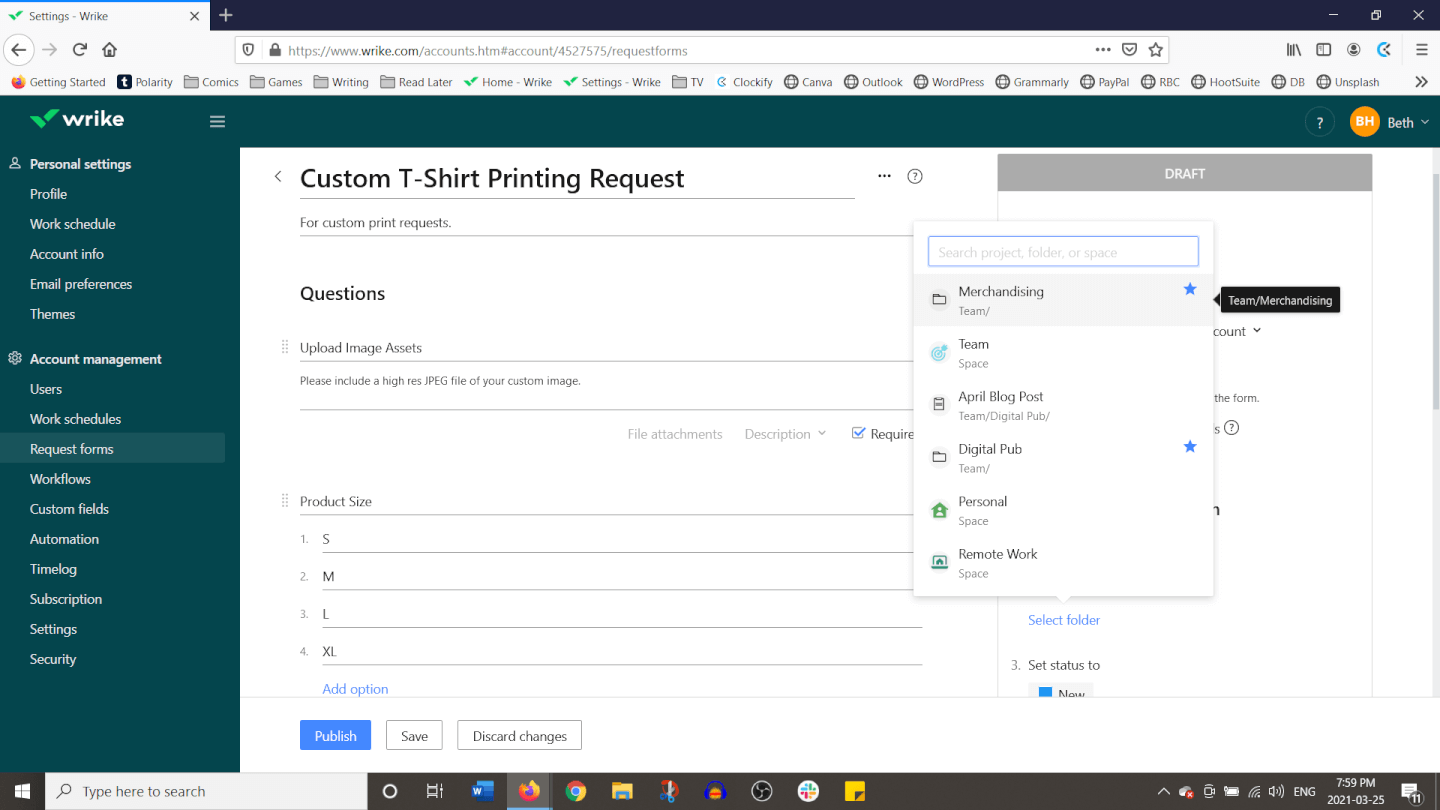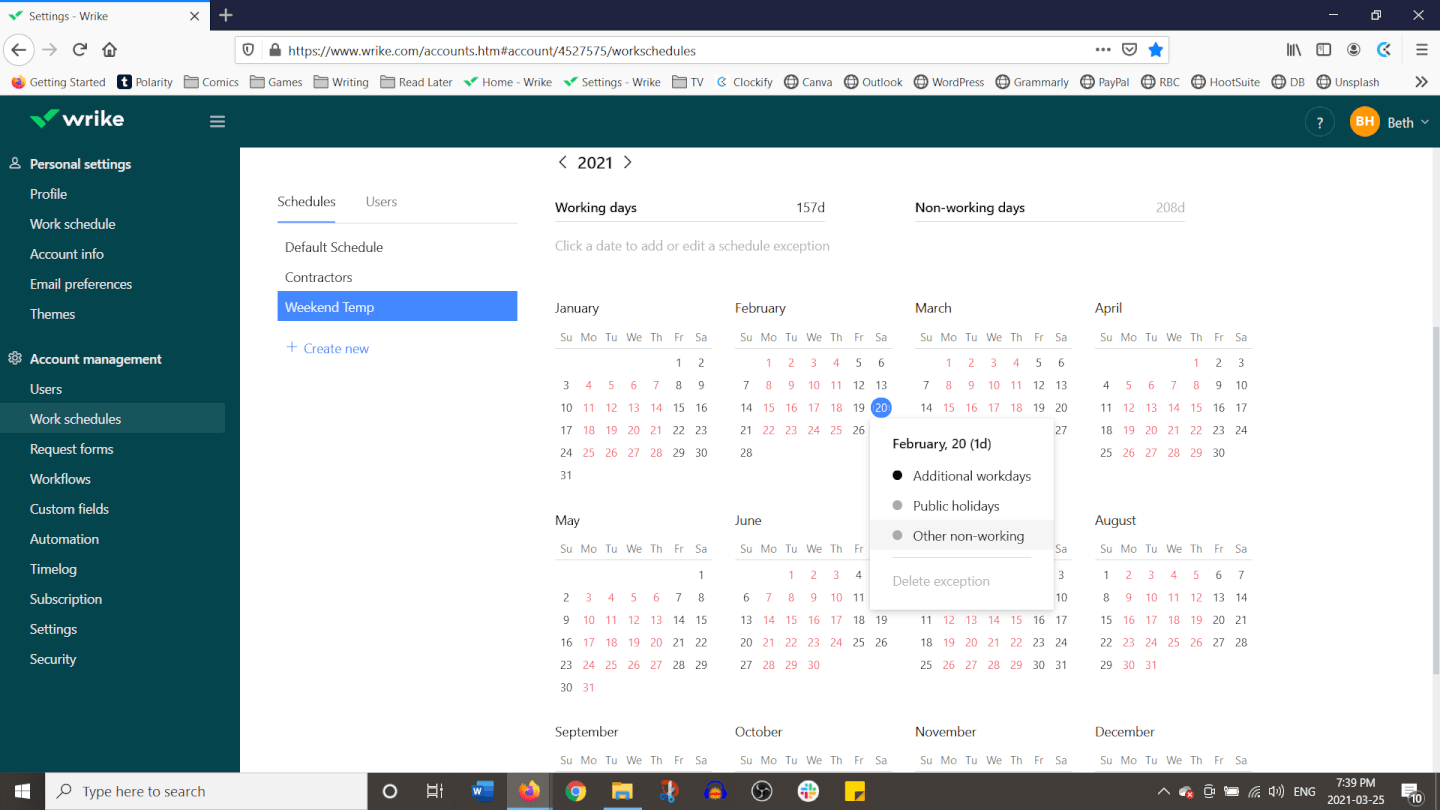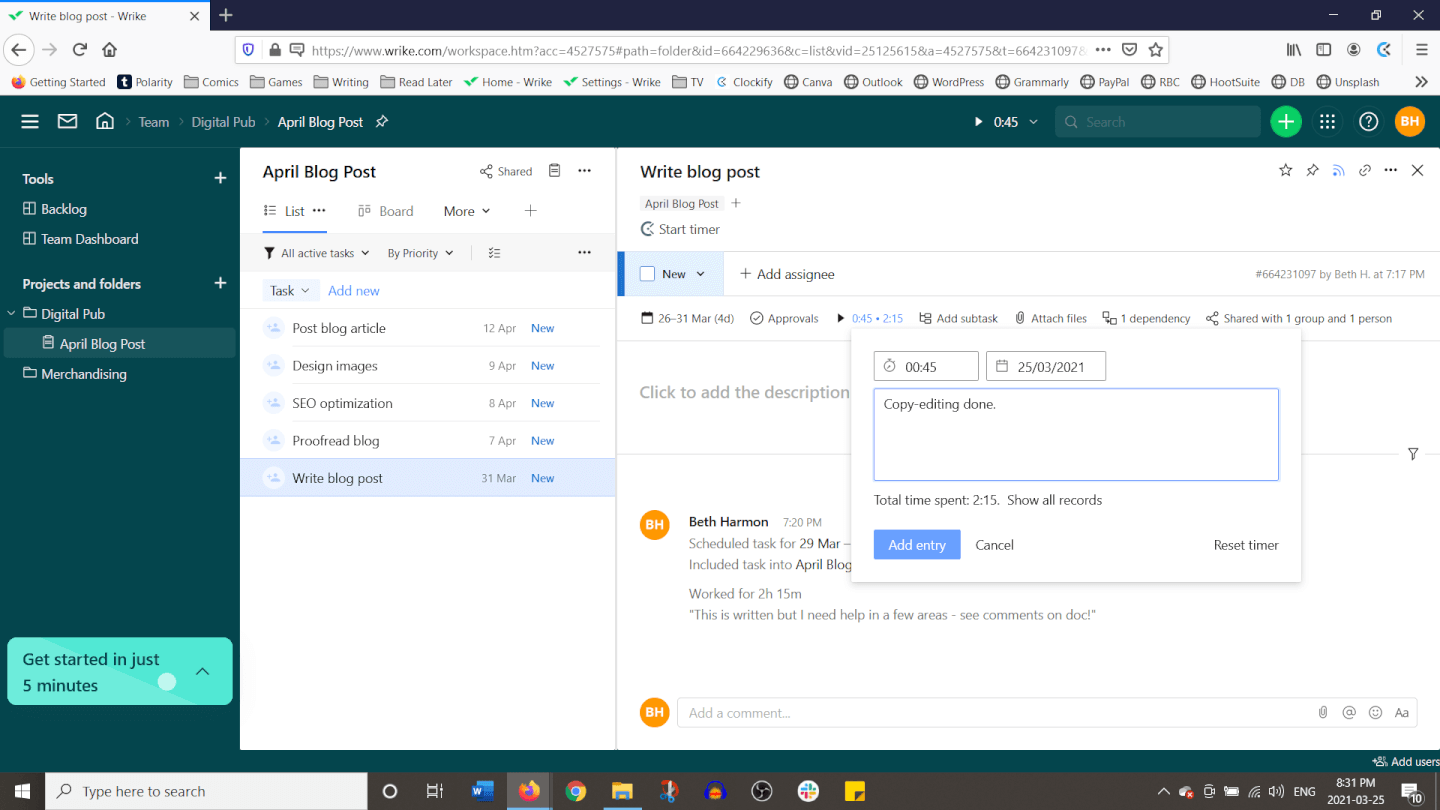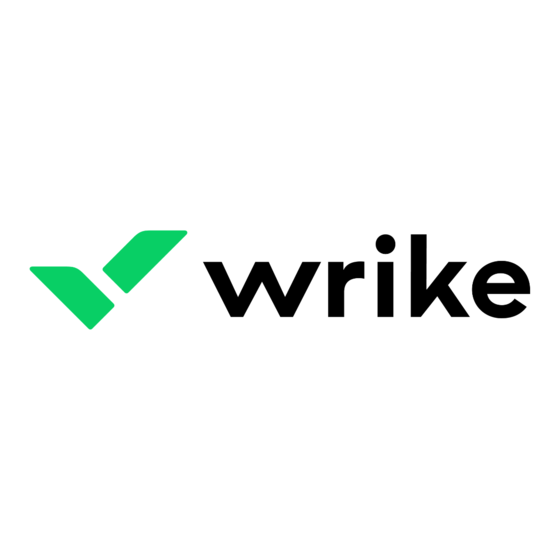Wrike is a project management software that specializes in cross-departmental communications and hand-crafted template documents that would benefit any fast-paced creative team. Within the app, you can build out their Spaces, Folders, Projects, Tasks, and Subtasks as they see fit. Users can lean on Blueprints (self-developed) or Templates (developed by Wrike) to speed up the process by which new items are entered into the workflow system. A custom request form builder with share-by-link access lets Wrike users build project request forms that external clients can fill out, as well. Wrike is very integration friendly, connecting with over 150 apps like Google Docs, Microsoft programs, Amazon services, and many more.
Wrike has a free plan with some feature limitations for an unlimited number of users.

$9.80/user/month min. 2 seats
Freemium version available
Pros and Cons
Pros
-
Users have access to a variety of customizable dashboards
-
Easily toggle between different project views (list, table, Kanban, Gantt)
-
Excellent email integration
-
Built-in help centers and documentation
-
Customized work schedules with day-off tracking
-
In-app time tracking for higher plans
Cons
-
Shareable dashboards are limited to paid plans
-
Only 2GB of storage space with the freemium plan
-
No alerts to warn against unassigned/untagged tasks
-
Some fun features are hidden deep in the menus
Wrike is a flexible project management tool that’s probably most useful for teams who want to build a library of consistent templates in order to speed up internal task and project requests. You will find that you can design a template for almost anything, from client request forms to high level task blueprints. Wrike cuts out the muss-and-fuss of hyper customizable tagging and flagging and keeps labels simple unless you tinker with the backend to open up more options. The out-of-the-box product will be perfect for teams who hate in-app clutter.
New users may struggle to find what they are looking for at first, as the Wrike interface has a few quirks—like the fact that some menu items have an in-app right-click option and others don’t or that a ton of useful features are buried in the Account Management menu via your profile settings. Once you suss out these details, they’ll be buried in your memory forever, which means you might want to set aside a bit of extra time for team training.
Wrike makes it easy for teams to speak to one another, coordinate task lists, and standardize request processes. It’s built to handle cross-departmental collaboration and in-app time tracking capabilities, and these are in fact some of the most positive features. Common critiques tend to center around a blasé interface design, steep learning curve, and 5-seat increments for adding users to each plan.
Overall, Wrike is a great choice for creative teams, agencies, and marketing departments that want to set-it-and-forget-it as they build project outlines, request forms, and task structures.
$9.80/user/month min. 2 seats
Freemium version available
-
Agile Project Management
Use Wrike to build Kanboard and customized workflows to best suit your Agile project management team. -
Client Management
Use Wrike for adept client management and professional services with collaborative planning tools, full project visibility, and automated approvals. -
Remote Work
Use Wrike to organize a remote workforce with in-browser and smartphone app access for a go-anywhere digital workspace. -
Business Process Management
Use Wrike to create customizable, sharable dashboards that enable team leads to monitor and improve processes. -
Event Planning
Use Wrike to visualize your event checklist and keep the whole team’s calendars automatically insync -
Product Roadmap
Use Wrike to visualize each roadmap stage using easy-to-build Gantt charts that highlight project launch priorities. -
Creative Teams
Use Wrike to organize creative requests, visualize your workload, clarify feedback, and publish assets with ease -
Marketing Teams
Use Wrike to optimize digital ROI with instant insights into up to 50 channels including all popular social platforms -
IT Teams
Use Wrike to build custom request forms for all IT ticket requests that can be set-up to automatically turn data into tasks
Features Demo
Wrike Features: 5 Things I Love
Here are some of the best features Wrike has to offer.
Custom Project Request Forms

Build your own custom request form with questions and prompts to collect all the data you need on the spot.
Custom project request forms are built from an easy-to-use template that lets users assign a title, ask questions, request files and assets, and automate the approval process. The request form can be accessed within Wrike under the task creation button or you can use a web link/embedded HTML to provide access to external participants. You can delegate who has access to each individual form request, what actions will be performed upon submission (ie. create a new project or task), who it will be assigned to, and who needs to approve it.
Work Schedule Management Tool
Build differing work schedules for full-time, part-time, and contract employees and assign them to users to help visualize how days off will affect your projects.

Customize each work schedule group to include days on VS days off, holidays, and exceptions.
The work schedule management feature lets you build different employee schedule groups and easily assign them to individual users. Wrike comes with a standard Monday-to-Friday, no statutory holidays work schedule upon sign up. You can then add your own subsets of schedules and record things like contractor availability. If you have weekend coverage, for example, you could design a work schedule group that accounts for Saturdays and Sundays as “working days” and all other weekdays as “non-working days.” This is an example of how Wrike fine-tunes your project and task scheduling according to the customized data you feed it.
Create Simple Workflow Automations
Simple workflow automation triggers pre-specified results to ease your team’s administrative workload.

Point-and-click and drop-down menus make building workflow automations easy in Wrike.
Wrike allows for basic workflow automation by letting a user assign what processes the app should follow when certain conditions are met. You can easily toggle each rule on or off, depending on whether you need them. The automations homepage will also calculate how many times each item was used within the month so you can check their effectiveness. Users simply select the targets (tasks from X folder, projects under X title), define the trigger for the automation, and select what should happen when these conditions are met.
Related Read: Complete Guide To Workload Capacity Planning: How To & Tools
Built in Task Time-Tracking
Time tracking is available on the Business Plan and above and lets you log time on a task with an embedded stop/start button.

A built-in timer can be activated to track the time spent on each task and leave notes for your team.
Wrike lets users track how much time is being spent on each task in real-time by simply pressing a start/stop button or adding time entries manually. Time entries can be paired with comments elaborating on the entry and all this data is logged in the task activity stream for all associated users to see. You can also design timelog categories (ie. learning and development, client relationships, daily tasks) for users to attach to each entry; this is optional and must first be activated in the Account Management menu.
Apps & Integrations Options
Choose from over 150 apps to integrate with Wrike or access their API for additional integration options.

Wrike connects with many 3rd-party apps for AI, analytics, finance, email, and sales.
Wrike offers an app directory with listings of over 150 3rd-party tools that can integrate with the software. You can choose from a variety of popular categories, like collaboration, HR, and productivity. You’ll find integration opportunities with many popular workforce apps: Adobe Creative Cloud, Airtable, G Suite, Outlook, JIRA, various Amazon services, Facebook, Mailchimp, Slack, and many more. Software developers can also leverage their free API access to build custom integrations. Their paid add-on Wrike Integrate unlocks 400+ custom integrations with apps like Basecamp, Asana, Trello, Quickbooks, and Monday.com.
Wrike Screenshots
Wrike Pricing

Free
The Wrike Free plan is available for up to 5 users and is best for small teams and freelancers. Features include a board view, task management, file sharing, a real-time activity stream, a spreadsheet view, basic integrations (Google Drive and Microsoft Office 365), and both desktop and mobile apps. This plan offers cloud storage integration with Google Drive, Dropbox, Box, Microsoft Office 365, and OneDrive. The Free Wrike plan comes with 2 GB native storage space. The free version of Wrike is a welcoming offer for small businesses and teams just getting started.
Professional
The Wrike Professional plan is best for 5-15 users and comes with everything in the Free plan as well as additional features like task and subtask management, Gantt charts, advanced integrations (MS Project, Excel, RSS), shareable dashboards, and collaborators. The Professional Wrike plan comes with 5 GB of native storage space.
Business
The Wrike Business plan is suitable for anywhere between 5-200 users and comes with robust work management tools with customization and executive reporting. Here, you’ll have access to all of the features of the lower plans as well as custom fields and views, shared real-time reports with scheduled notifications, report templates, graphical analytics, calendars, request forms, project and task approvals, time tracking, user group and permissions, Salesforce integration, and an automation engine. You will also have a custom branded workspace to match your company aesthetics. The Wrike Business plan comes with 50 GB of native storage space. The Business plan can also be expanded with the Wrike for Marketers/Wrike for Marketers Performance packages or the Wrike for Professional Services/Wrike for Professional Services Performance packages. Each of these unlocks additional functionality for marketing and service delivery project managers respectively.
Enterprise
The Wrike Enterprise plan allows for unlimited users and is a comprehensive solution for large-scale businesses with advanced security and controls. You will have access to all features from the lower plans as well as Active Directory integration, SAML 2.0 Single Sign-On, two-factor authentication, password policies, IT controlled admin permissions, user audit reports, network access and compliance policies, business intelligence integration, and advanced user controls. The Wrike Enterprise plan comes with 100 GB of native storage space and more can be purchased as required.
Pinnacle
Wrike’s pinnacle plan is one step beyond the Enterprise level and includes everything in the plans that come before it. Additionally, you’ll get: locked spaces, advanced BI and analytics capabilities, team utilization and performance dashboard, job roles, budgeting and billable hours, bookings (project-level effort & time planning), SharePoint and HTML5 proofing and approvals, digital asset management integrations, automation Engine with 1500 actions/user/month, and 15 GB storage per user.
Add-Ons
For an additional fee, Wrike offers the following upgrades to certain paid plans:
- Wrike Integrate: Custom integration with 400+ apps
- Wrike Lock: Own the keys to your encrypted Wrike data
- Two-Way Sync with GitHub & JIRA: For two-way sync between tasks and issues
Note that as of July 1, 2021, Wrike has integrated used-to-be add-ons Wrike Resource, Wrike Proof, Wrike Publish, and Wrike Analyze directly into the primary platform and correspondent subscription plans.
Support & Deployment
Support
Wrike provides support through email, chat, phone, and their Help Center. They have dedicated customer service numbers across North America, Latin America, Europe, as well as for Australia and Japan, with appropriate language support for each.
Training
Wrike offers a wealth of training opportunities in the form of video tutorials, product demos, live monthly webinars, best practices and cheat sheets, community forums, and through customer support directly.
Deployment
Thanks to their free plan and free trials, Wrike can be up and running for you in a matter of the few minutes it takes to sign up for an account. From there, built-in walkthroughs and video tutorials will get you started. Expect a few dedicated hours to build your first fully-fledged project.
Monday.com Best Reviews
John C. On G2
Wrike has a very friendly user interface allowing you to get started with projects quickly and easily. Wrike stands behind their software product by giving great customer service and continuing to listen to users about enhanced features.
Adam A. On Capterra
Generally positive experience of Wrike as a whole. Infinitely easier to organise, communicate and collaborate within a large organisation in comparison to traditional methods. The ability to delegate easily and efficiently makes this a pleasure to use.
Gabriel On Software Advice
Wrike is an exceptionally well-developed tool that even offers integration with Outlook to help keep project communication and schedules organized and on-time. I’m a big fan of squeezing every additional second of my day, and as such, I’m constantly trying to do more in less time! Wrike keeps my projects on-time & on-budget, while allowing client collaboration.
Sanskriti G. On Getapp
Overall, we had a positive experience with the application. We deployed Wrike at our desk, and were able to get optimum results. We were able to manage 250+ employees from a single application. With Wrike we were able to track everything including project schedules, working hours, ongoing tasks with detailed reports and analytics with visualizations and work flows. So, I would prefer Wrike when it comes to project management, and it has been a great asset for team collaboration and event handling.
Marcus On Finances Online
Wrike is made for managing various projects with various team members. We use it to keep track of all the activities during the last week and while performing weekly team meetings. It allows you to create projects and subtasks within the same project. I like the upload attachment feature so we can easily track the tasks that are related to specific documents instead of searching them through emails. Also, the dates on the tasks are also helpful and I like that I get To Do lists emailed with all the dates prioritized.
Wrike Customers
Final Verdict
If you can get past some of the interface quirks, Wrike is a solid choice for digital workspace management that favors flexibility and customizability. Being able to build your own task blueprints, request form templates, work schedule groups, and even API integrations means that you will get out what you put in. Be prepared for a solid initial time investment to learn the tool, but know that it is worth the payout.




















